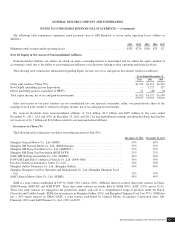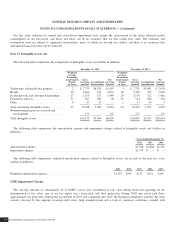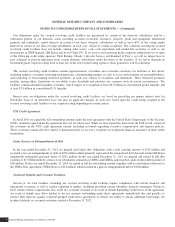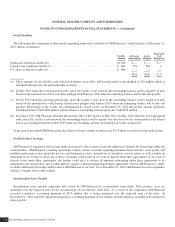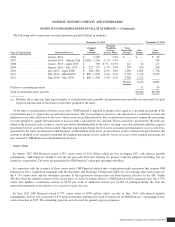General Motors 2012 Annual Report Download - page 114
Download and view the complete annual report
Please find page 114 of the 2012 General Motors annual report below. You can navigate through the pages in the report by either clicking on the pages listed below, or by using the keyword search tool below to find specific information within the annual report.
GENERAL MOTORS COMPANY AND SUBSIDIARIES
NOTES TO CONSOLIDATED FINANCIAL STATEMENTS — (Continued)
overcapacity. During this timeframe, we began to experience deterioration in cash flows. In response, we formulated a plan to
implement various actions to strengthen our operations and increase our competitiveness. The key areas of the plan include
investments in our product portfolio, a revised brand strategy, significant management changes, reducing material, development and
production costs, and further leveraging synergies from the alliance between us and PSA.
We believe it is likely that adverse economic conditions, and their effect on the European automotive industry will not improve
significantly in the short-term and we expect to continue to incur losses in the region as a result. During the fourth quarter of 2012,
notwithstanding the above described actions, GME performed below expectations relative to the key operating metrics of forecasted
revenues, market share, and variable profit established in mid-2012. Further, our industry outlook deteriorated, and our forecast of
2013 cash flows declined. This triggered a long-lived asset impairment analysis.
We performed a recoverability test of the GME asset group by weighting various undiscounted cash flow scenarios. The weighting
of the projected cash flows considers the uncertainty in our ability to execute the actions contemplated in our plan which, in part, are
dependent upon actions and factors outside our control. Our test concluded that the GME asset group was not recoverable as the
resulting undiscounted cash flows were less than their carrying amount. Accordingly, we estimated the fair value of the GME long-
lived assets to determine the impairment amount. Determining the fair value is judgmental in nature and requires the use of significant
estimates and assumptions, considered to be Level 3 inputs.
To determine the estimated fair value of the brand intangible assets, we used the relief from royalty method, which is a form of the
income approach. Under this approach, revenue associated with the brand is projected over the expected remaining useful life of the
asset. A royalty rate is then applied to estimate the royalty savings. The royalty rate used was based on an analysis of empirical,
market-derived royalty rates for guideline intangible assets and a profit split analysis to determine a rate that is economically
supported by GME’s forecasted profitability. The net after-tax royalty savings are calculated for each year during the remaining
economic life of the asset and discounted to present value.
To determine the estimated fair value of the dealer network, we used the cost approach with adjustments in value for the
overcapacity of dealers and the sales environment in the region. We determined the fair value to be $0.
The following table summarizes the significant Level 3 inputs for brand intangible assets measurements:
Valuation Technique Unobservable Input(s) Percentage
Brand intangible assets ........................................... Income approach Long-term growth rate 0.50%
Pre-tax royalty rate (a) 0.14%
Discount rate (b) 21.25%
(a) Represents estimated savings realized from owning the asset or having the royalty-free right to use the asset.
(b) Represents WACC adjusted for perceived business risks related to these intangible assets.
As a result of our fair value estimates, we adjusted the carrying amount of the GME intangible assets to fair value and recorded
asset impairment charges of $1.8 billion at December 31, 2012. These charges were recorded in our GME segment with $1.6 billion
recorded in Automotive selling, general and administrative expense and $0.2 billion recorded in Automotive cost of sales. The fair
value estimates for GME’s intangible assets are based on a valuation premise that assumes the assets’ highest and best use are
different than their current use due to the overall European macro-economic environment.
The following table summarizes brand intangible assets in GME measured at fair value utilizing Level 3 inputs on a nonrecurring
basis (dollars in millions):
Fair Value Measure Level 1 Level 2 Level 3 Total Impairment
Year ended December 31, 2012 ............................... $139 $—$— $139 $1,755
General Motors Company 2012 ANNUAL REPORT 111


